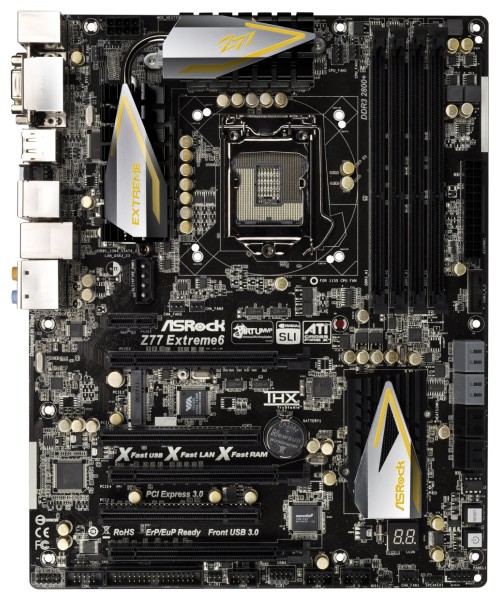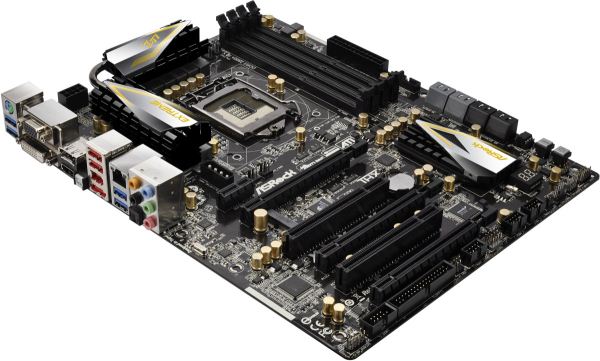Intel Z77 Panther Point Chipset and Motherboard Preview – ASRock, ASUS, Gigabyte, MSI, ECS and Biostar
by Ian Cutress on April 8, 2012 12:00 AM EST- Posted in
- Motherboards
- Intel
- Biostar
- MSI
- Gigabyte
- ASRock
- Asus
- Ivy Bridge
- ECS
- Z77
ASRock Z77 Extreme6—Visual Inspection
With the Extreme6, compared to the Extreme4, there are a significant number of changes, both visual and in terms of features. For a start, the heatsink design is more pronounced, using something similar to their X79 range in terms of black and gold ridged and edged surfaces. The VRM heatsink design is more substantial than the Extreme4, even though online it states it is still only an 8 + 4 VRM design—actually looking at the board, it seems more of a 10 + 4 design.
By looking at the motherboard, you would assume that it would support three-GPU setups. Unfortunately, this third full-length PCIe lane is only PCIe 2.0 x4, rather than splitting up the PCIe 3.0 lanes x8/x4/x4 or using a PLX chip. The MSRP for this board should be around $177, indicating that perhaps that is too cheap a board for one of the expensive PCIe 3.0 expansion PLX chips.

Onboard is also an mSATA port, right in the middle between the first PCIe slot and the PCI slot. Above the PCIe slots is a 4-pin molex power connector to provide extra power to the PCIe slots, although I am kind of getting tired of seeing it put in this location. If anything, it should be at the bottom end or beside the 24-pin power connector, as having it above the PCIe slots just means that there will be cables all over the place.
One other less obvious change to the Extreme4 is that there is a Floppy drive header on board. Yes, you heard me right—floppy drive! It seems odd now to include this legacy connection. It still has a place in industrial concepts (where a machine uses floppy drives and costs 1000x more than the PC processing its data), but not particularly on a higher end product which may be geared towards gaming and overclocking. Perhaps if ASRock are the only ones, then it creates a niche just for them.
In terms of fan headers on board, we have one three-pin beside the 8-pin 12V power connector, two CPU headers (one 4-pin, one 3-pin) just to the right of the top heatsink, two chassis three-pin headers beside the molex connector, and another 4-pin chassis header on the bottom of the board. On the right hand side, the USB 3.0 connector has been placed beneath the 24-pin ATX power connector, followed by the SATA ports. Like the Extreme4, we have the PCH SATA ports (two SATA 6 Gbps and four SATA 3 Gbps) and two extra SATA 6 Gbps from an ASMedia ASM1061 controller.
Around the larger chipset heatsink, we have power/reset buttons and a two digit debug display, both of which I personally like to see as a reviewer (makes my job a bit easier) but also helps overclockers. On the south side of the board, apart from that floppy connector I mentioned, we have a COM port, front panel audio, and an array of USB 2.0 headers.
PCIe layout is similar to the Extreme6, with a PCIe x1, PCIe 3.0 x16/x8, an mSATA connector, PCI, PCIe 3.0 x8, PCI, and a PCI 2.0 x4. This allows a user to use a dual GPU setup, and still have access to a PCIe x1 and x4.

Aside from the bowed picture from ASRock, we have something similar to the Extreme4 for the IO back panel, though this time with a DisplayPort output. From left to right, we have a combination PS/2 port, two USB 3.0 ports (blue), a D-Sub port, DVI-D, DisplayPort, HDMI, a ClearCMOS button, two USB 2.0 (red), an IEEE1394 port, eSATA, gigabit Ethernet, two more USB 3.0 (blue), and audio outputs including an optical SPDIF.
Board Features
| ASRock Z77 Extreme6 | |
| Size | ATX |
| CPU Interface | LGA-1155 |
| Chipset | Intel Z77 |
| Power Delivery | 8 + 4 |
| Memory Slots |
Four DDR3 DIMM slots supporting up to 32 GB Up to Dual Channel, 1066-2800 MHz |
| Video Outputs | DisplayPort, HDMI 1.4a, DVI-D, D-Sub |
| Onboard LAN | Broadcom BCM57781 |
| Onboard Audio | Realtek ALC898 |
| Expansion Slots |
2 x PCIe x16 Gen3 (x16, x8/8) 1 x PCIe x16 Gen2 (x4) 1 x PCIe x1 Gen2 2 x PCI 1 x mini PCIe |
| Onboard SATA/RAID |
2 x SATA 6 Gbps (PCH), Support for RAID 0, 1, 5, 10 2 x SATA 6 Gbps (ASMedia ASM1061) 4 x SATA 3 Gbps (PCH), Support for RAID 0, 1, 5, 10 |
| USB |
Two USB 3.0 at rear (PCH) Two USB 3.0 at rear (Etron EJ168A) One USB 3.0 header (PCH) |
| Onboard |
4 x SATA 6 Gbps 4 x SATA 3 Gbps 1 x Floppy Connector 1 x IR Header 1 x CIR Header 1 x COM Header 1 x SPDIF Header 1 x 4-pin Molex power connector Power/Reset Buttons Two Digit Debug LED 6 x Fan Headers Front panel audio connector 3 x USB 2.0 headers (support 6 USB 2.0 ports) 1 x USB 3.0 header (supports 2 USB 3.0 ports) |
| Power Connectors |
1 x 24-pin ATX connector 1 x 8-pin 12V connector 1 x 4-pin Molex for PCIe |
| Fan Headers |
2 x CPU Fan Header (one 4-pin, one 3-pin) 3 x CHA Fan Headers (one 4-pin, two 3-pin) 1 x SYS Fan Header (one 3-pin) |
| IO Panel |
1 x Combo PS/2 Port 1 x DisplayPort 1 x HDMI 1.4a 1 x DVI-D 1 x D-Sub 1 x Optical SPDIF 2 x USB 2.0 4 x USB 3.0 1 x IEEE1394 1 x Gigabit Ethernet 1 x Clear CMOS Audio Outputs |
| Warranty Period | 3 years from date of purchase |
| Product Page | Link |
Nothing immediately jumps out from the board features list aside from the differences to the Extreme4. This is a quite good package for an MSRP of $171.











145 Comments
View All Comments
mechjman - Monday, April 9, 2012 - link
I don't remember seeing PCIe 3.0 support straight from P6x series chipsets.http://www.intel.com/content/www/us/en/chipsets/ma...
If this is regarding in use with a PLX chip, it might be good to state so.
extide - Tuesday, April 10, 2012 - link
It's actually when the boards DONT use a plx chip, or if the use 3.0 capable ones. It's only the boards that use 2.0 chips that are limited to 2.0GameLifter - Tuesday, April 10, 2012 - link
I am very curious to see how this technology will affect the overall performance of the RAM. If it works well, I may have to get the P8Z77-V Pro.jbuiltman - Tuesday, April 10, 2012 - link
I am leaving my AMD FX-60, 3 GB DDR, Asus 939 Delux, Win XP, Raptor 150 HDD for IVY Bridge pasures!!!I am all for ASUS 16+4 power, multi usb 2.0 and 3.0 on the back panel. I also like the multiple 4 pin fan plug ins, mem ok, LED problem indicator, switches, 4 SATA 6GB connectors and heat pipes connecting the alunimum fins.
What i want to see is 16x/16x not 8x/8x on dual video card on a Z77 board. ASUS, don't skimp for a measly $30! I hate cheap companies and don't make me think you are just being cheap!!!
jbuiltman - Tuesday, April 10, 2012 - link
Hey all you MoBo companies. Don't get cheap with the Z77 boards and not include 16x/16x on the pci-e 3.0!!!! Come on, add what you need to and pass the $30 on to me!!!!ratbert1 - Wednesday, April 11, 2012 - link
"ASUS as a direct standard are now placing Intel NICs on all their channel motherboards. This is a result of a significant number of their user base requesting them over the Realtek solutions."Um... ASUS P8Z77-V LX has Realtek!
and...ASUS P8H77-M PRO has Realtek!
There are more.
ratbert1 - Wednesday, April 11, 2012 - link
I meant P8Z77-M PRO, but the H77 has it as well.lbeyak - Sunday, April 15, 2012 - link
I would love a detailed review of the Gigabyte G1.Sniper 3 Z77 board when it becomes available.Keep up the good work!
csrikant - Sunday, April 22, 2012 - link
Dual E5-2690So far best i have got burn a lot $$$ to get this right
my last build was with I7 990x got itchy in oct 2011 with some minor issue decided to change my PC got my i7 2700K did not meet my expectation
built i7 3960x still failed many of my requirements regret my pc change from 990x
Finally with all my pain and wasting$$ got my new build that so far perform better than my 990X build
My advice do not get carried away by fancy new i7 release they are just little benefit for P4 just wasting time I was shocked that they released P4 with 1155 socket it was having same performace as 2700K not much change in fact it was cheaper too.
Am not expert an average system builder but my advice from bottom of my heart is just go for E5 build if you are really looking for performace and some benefits you may spend some extra $$ on MB ,CPU,Casing etc it is worth in long run works out cheper than any fancy High end gaming rig water cooling etc all just shit tech advice. Never get ferrari performance form mod toyota.
mudy - Monday, April 23, 2012 - link
With the third pcie lane on the z77 boards I have come across almost all manufacturers saying "1xPCI Express 2.0 x16 (x4 Mode) & only available if a Gen 3 CPU are used". Does this mean that the lane is pcie 2.0 at x16 but works at pcie 3.0 x4 mode, if an IVB processor is connected, and other two pcie 3.0 lane is populated giving x8/x4x4 speed with pcie 3.0 compliant cards?? Also what will happen if I put Pcie 2.0 GPUs in the first two pcie 3.0 x16 slots and a pcie 2.0 compliant raid card (rr2720SGL) in the third pcie lane? Will it give me an effective pcie 2.0 bandwidth of x16/x8/x8 or not?? Damn these are so confusing!! I wish anandtech would do an extensive review on just the pcie lanes covering all sorts of scenario and I think NOW would be the best time to this as the transition from pcie 2.0 to pcie 3.0 will happen slowly (maybe years) so majority end-user will still be keeping their pcie 2.0 compliant devices!!Thanks